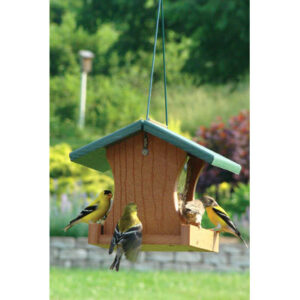Last year New York State made the news constantly for confirmed cases of birds being infected by Salmonella. The primary way this bacteria spreads is through uncleaned bird feeders. So far 2014 is quieter, but her at BirdhouseSupply.com, we’d like to help keep it this way. With just a few basic maintenance steps, you’re backyard birds will stay healthy and safe.
Common diseases among birds
 Salmonellosis is the primary concern for songbirds in your backyard. This disease is spread between species like cardinals, sparrows and goldfinches. It is most likely to be spread at bird feeders, generally coming from the birds’ excrement. However, it can also spread through infected seed or water.
Salmonellosis is the primary concern for songbirds in your backyard. This disease is spread between species like cardinals, sparrows and goldfinches. It is most likely to be spread at bird feeders, generally coming from the birds’ excrement. However, it can also spread through infected seed or water.
Beyond the health of the birds, Salmonellosis–also known as Songbird Fever–can be spread to dogs, cats and other domestic animals. This means it is a zoonotic disease which even humans are susceptible to.
Keeping birds safe
Bird feeders are a safe and pleasant way to watch the antics of wild birds. A few simple cleaning steps will keep your feeders safe from disease. Follow these three simple maintenance steps:
1. Empty bird feeders
Weekly basic cleaning will do a lot to keep your feeder in tip top shape.
For platform feeders, empty them of seed completely and wipe the feeder out each week. Adding small amounts of food a few times per week makes this process much easier and prevents seed from going bad if it goes uneaten.
For tube feeders, wipe down the portals and outside of the feeder each week. It is unnecessary to completely empty the tube unless you see evidence of moisture in the tube.
For nectar feeders, completely empty and clean the feeder each time nectar is refilled (at least every other day). This is an essential part of keeping Hummingbirds and Orioles safe and visiting your yard. Nectar spoils easily and attracts insects so constant cleaning is a must.
2. Clean feeders thoroughly
Once or twice each month take the time to thoroughly clean your bird feeders with hot soapy water. For wood feeders, empty them and wipe down with a rough sponge or rag. For synthetic feeders, soak them in a solution of 10% bleach-to-90% water for 60-90 minutes. Then, rinse thoroughly and dry before refilling.
3. Clean around your bird feeder
In addition to cleaning the feeder itself, it is essential to clean away discarded seed and waste underneath and around your bird feeders. This will help keep pests away, keep birds from pecking in areas where waste may have built up and look better in your yard.
Always wear gloves when cleaning your bird feeders to avoid any bacteria that could be growing there. If you happen to see a bird exhibiting symptoms of sickness such as lethargic movement, long periods of sitting with eyes closed or difficulty eating, contact your local fish and wildlife agency for help.
By following the simple steps above, your bird feeders will stay clean and will keep your backyard free of unwanted bacteria and germs. Birds, just like humans, need a clean and dry place to eat!

